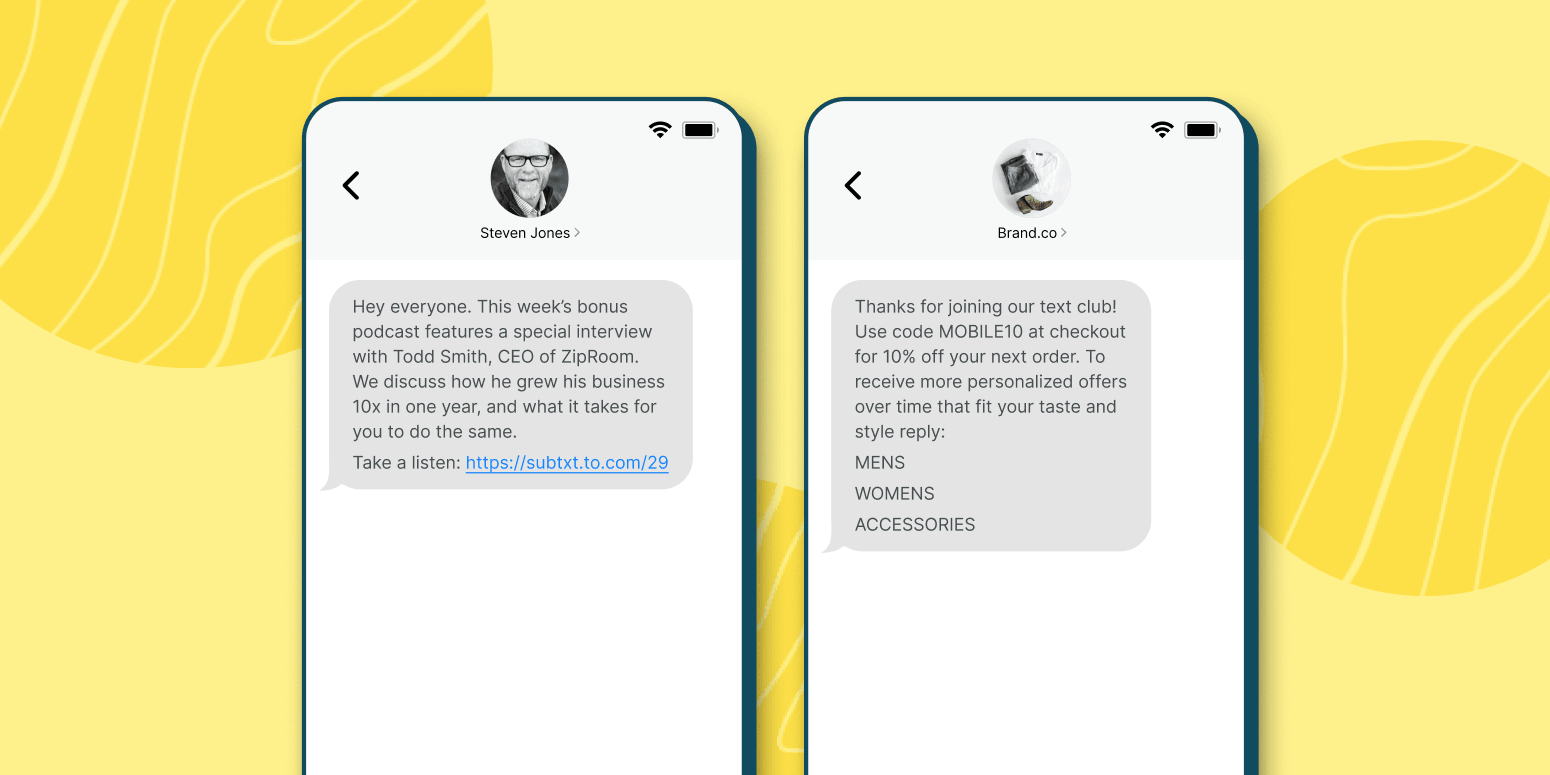
A2P vs P2P Messaging: What’s the Difference?
If you’re like 9 out of 10 Americans, chances are your smartphone’s native messaging app (whether that’s Apple’s iMessage or Android messaging) is your go-to communication hub. It’s where you connect, share, and stay in touch—far more than any other channel.
Every day, billions of text messages ping across mobile networks around the world, coming from family, friends, and even brands. There’s a big difference, though, between a casual text from your best friend and crafted marketing messages from a company. Wireless carriers distinguish these messages as person-to-person (P2P) and application-to-person (A2P).
So what’s the deal with A2P vs. P2P messaging and how does Subtext fit in?
A2P vs. P2P: A Clear Comparison
When comparing A2P vs. P2P SMS, the key differences lie in:
- The nature of communication
- The scale of messaging
- Regulatory considerations
P2P messaging is typically a one-on-one conversation between two individuals in real time. A2P messaging, however, involves a business or brand sending messages to multiple recipients at the same time. These messages are often transactional or promotional.
In the world of SMS, P2P vs. A2P messaging both meet different communication needs.
P2P Messaging: What Is P2P SMS?
Person-to-person messaging (P2P SMS) is the digital equivalent of a face-to-face conversation. It’s the type of messages most consumers use daily, like quick texts between you and the people that you care most about. P2P messaging is fundamentally conversational in nature, and can include family group texts, private texts to friends, and work-related exchanges with colleagues.
P2P messaging occurs in real-time without the aid of SMS messaging platforms and other technologies. It’s perfect for personal use, but it presents challenges for business messaging:
- Tightly regulated by wireless carriers. Brands face a higher risk of being marked as spam.
- Increased potential for penalties. Mass P2P messaging risks lower deliverability rates, higher tariffs, and messaging costs.
- Limited scalability. The one-to-one can be inefficient for reaching large audiences.
Under some circumstances, P2P messaging may also include API-mediated traffic to connect two people. However, some countries (including the US and Canada) don’t consider this to be true P2P.
For businesses ready to engage with customers via text, it’s important to understand these limitations when developing an SMS messaging strategy.
A2P Messaging: What Is A2P SMS?
Application-to-person messaging, or A2P SMS, is the business-oriented counterpart to P2P. Consider A2P messaging as inherently non-conversational and often more transactional in nature. A2P SMS allows a sender, in this case, any business, to send messages to thousands of customers at once, usually through automated systems.
The defining characteristics that separate A2P vs. P2P can be summarized through A2P’s diverse use cases, including:
- A gate change notification from your airline before you catch a flight
- A coupon for 10% from your favorite clothing store
- A political party encouraging you to vote or volunteer
- A trusted news source sending you a rundown of that day’s top stories
Messages are usually sent through SMS marketing or engagement technology platforms, or SMS APIs. In most cases, customers need to opt-in and consent to receive these messages.
A2P messaging greatly outperforms P2P messaging in almost all core KPI categories for business:
- Broad reach. A2P messaging connects businesses to a (nearly) unlimited number of customers in minutes.
- Resource-effective. A2P saves time, money, and resources by automatically sending texts to preset contact lists.
- Customer-friendly. It meets the needs of a larger number of subscribers on the medium they prefer and that is always near them, if not in their hand.
- High performance. A2P vs. P2P SMS performance data reveals a clear advantage with higher deliverability, open rates, and call-to-action responses.
An A2P messaging strategy elevates businesses looking to connect with subscribers on a larger scale while maintaining compliance with messaging regulations.
Which Is the Best SMS: P2P vs. A2P?
When deciding between A2P vs. P2P for your business, consider your communication goals and scale:
- Small businesses and individuals looking to engage one-on-one with their audience may succeed with P2P messaging.
- Most businesses, especially those aiming to reach a larger audience, will find more success with A2P messaging.
A2P is a clear winner for its superior deliverability, scalability, and adherence to wireless regulations. It’s the ideal choice for the large majority of marketing campaigns, customer services, and bulk communications. Check out these case studies to see how successful an A2P strategy is.
How Does Subtext Fit In?
While A2P messaging is typically non-conversational, Subtext revolutionizes this concept by bridging the gap in the A2P vs. P2P divide. We’ve engineered our A2P messaging platform to blend the best of both worlds: all the deliverability and reliability of the best SMS marketing platforms with the ability to seamlessly transition from one-to-many straight to one-to-one conversations.
Unlike rigid SMS marketing platforms that place customers into inflexible frameworks, we built Subtext with flexibility that allows customers to truly personify their brand. This approach allows our customers to send hundreds of thousands of messages per day that resonate like personal messages with their subscribers.
Subtext’s flexible features include:
- Seamless scaling
- Individual personalization
- Audience segmentation
- Engagement through two-way conversations
- Automated scheduling
Subtext makes it easier than ever for brands to communicate authentically with their audience, transforming what has historically been a transactional, impersonal medium into a dynamic, engaging conversation. Learn more about how we get this done for our customers.
Ready to elevate your strategy with Subtext? Book a demo today.